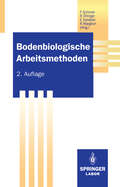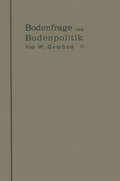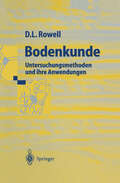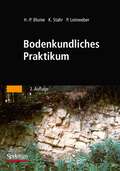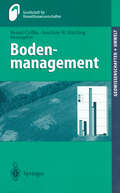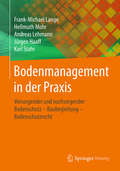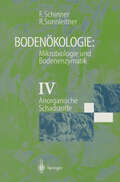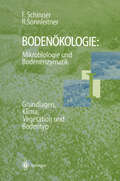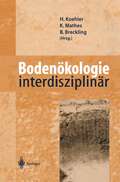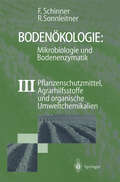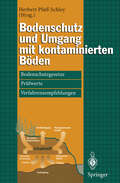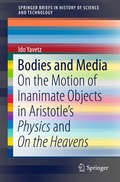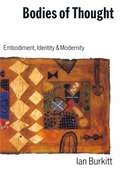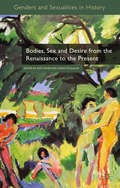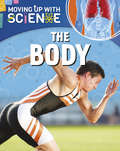- Table View
- List View
Bodenbiologische Arbeitsmethoden (Springer Labormanuale)
by Franz Schinner Richard Öhlinger Ellen Kandeler Rosa MargesinDie Messung biologischer Parameter von Böden erlaubt eine rasche Beurteilung der Auswirkung chemischer und physikalischer Einflüsse auf den Boden. Dieses Buch stellt eine Vielzahl von enzymatischen Methoden vor, die zur Erfassung von Aktivitäten aus dem Kohlenstoff-, Stickstoff-, Phosphor- und Schwefelkreislauf geeignet sind. Ebenso wird die Bestimmung der Biomasse von Mikroorganismen, Algen und Tieren des Bodens beschrieben. Das Methodenspektrum wurde gegenüber der ersten Auflage um einen zoologischen Teil und zahlreiche aktuelle mikrobiologische Methoden erweitert. Bei den Arbeitsvorschriften wurde besonders auf eine verständliche und vollständige Beschreibung der experimentellen Abläufe geachtet.
Bodenfrage und Bodenpolitik in ihrer Bedeutung für das Wohnungswesen und die Hygiene der Städte: Eine Untersuchung über die wirtschaftlichen Voraussetzungen der Städtehygiene für Architekten, Ingenieure, Verwaltungsbeamte, Hygieniker und alle Interessenten der städtischen Wohnungsfrage
by W. GemündDieser Buchtitel ist Teil des Digitalisierungsprojekts Springer Book Archives mit Publikationen, die seit den Anfängen des Verlags von 1842 erschienen sind. Der Verlag stellt mit diesem Archiv Quellen für die historische wie auch die disziplingeschichtliche Forschung zur Verfügung, die jeweils im historischen Kontext betrachtet werden müssen. Dieser Titel erschien in der Zeit vor 1945 und wird daher in seiner zeittypischen politisch-ideologischen Ausrichtung vom Verlag nicht beworben.
Bodenkunde: Untersuchungsmethoden und ihre Anwendungen
by David L. RowellFruchtbarer Boden wird mit zunehmendem Bevölkerungsdruck und wachsendem Nahrungsmittelbedarf immer knapper. Ein verantwortungsvoller Umgang mit dieser essentiellen Ressource ist daher dringend notwendig. Mit der Übersetzung der erfolgreichen Bodenkunde von Rowell liegt nun ein praktisches Lehr- und Methodenbuch vor, mit dem sämtliche Bodeneigenschaften gemessen und bewertet werden können. Neben den bodenkundlichen Grundlagen werden die Prinzipien der Meßverfahren und deren Durchführung ausführlich beschrieben. Auswertung und Interpretation der Meßdaten wird durch Rechenbeispiele und Übungsaufgaben erleichtert. Mit den zahlreichen praktischen "Übungen im Feld" lassen sich die Labormethoden auch ohne aufwendige Mittel direkt in die Praxis übertragen.
Bodenkundliches Praktikum: Eine Einführung in pedologisches Arbeiten für Ökologen, Land- und Forstwirte, Geo- und Umweltwissenschaftler
by Hans-Peter Blume Karl Stahr Peter LeinweberWie wird ein Boden aus einem Gestein? Entwickelt er dabei Eigenschaften, die für Organismen nützlich oder nachteilig sind? Wie bestimmt man diese Vorgänge und Eigenschaften? Zur Klärung derartiger Fragen steht eine große Anzahl von Methoden zur Verfügung. Aufgabe dieses Buches ist es, den Benutzer mit solchen Methoden vertraut zu machen, die in der Praxis häufig angewendet werden. Es bietet einen exemplarischen Überblick über die Grundlagen, die Arbeitstechniken im Gelände und im Labor, und über die Auswertung der Befunde von bodenkundlichen Untersuchungen. Einen breiten Raum nimmt die Interpretation der Daten ein: Rekonstruktion der Bodenentwicklung, Richtung, Intensität und Dauer bodenbildender Prozesse, Kennzeichnung der ökologischen Standortfaktoren Durchwurzelbarkeit, Wasser-, Luft- und Nährstoffhaushalt, Filterfunktion des Bodens und Belastung des Grundwassers; Sicherung der Ergebnisse durch Umsatzmessungen, Boden- und Standortsvergleich. Daraus ergibt sich eine Ableitung boden- und umweltschonender Nutzungsmaßnahmen, die das Buch beschließt.
Bodenkundliches Praktikum
by Eilh. Alfred MitscherlichDieser Buchtitel ist Teil des Digitalisierungsprojekts Springer Book Archives mit Publikationen, die seit den Anfängen des Verlags von 1842 erschienen sind. Der Verlag stellt mit diesem Archiv Quellen für die historische wie auch die disziplingeschichtliche Forschung zur Verfügung, die jeweils im historischen Kontext betrachtet werden müssen. Dieser Titel erschien in der Zeit vor 1945 und wird daher in seiner zeittypischen politisch-ideologischen Ausrichtung vom Verlag nicht beworben.
Bodenmanagement in der Praxis: Vorsorgender und nachsorgender Bodenschutz – Baubegleitung – Bodenschutzrecht
by Frank-Michael Lange Hellmuth Mohr Andreas Lehmann Jürgen Haaff Karl StahrDie wichtigsten Gesetze und Verordnungen werden vorgestellt und die Rechtslage an Hand aktueller Rechtssprechung dargelegt. Erkundungs- und Bewertungstechniken werden beschrieben und kommentiert und die relevanten Normen und technischen Regelwerke sind aufgeführt. Das Buch gliedert sich in die drei Bereiche Altlasten, Abfalltechnik - soweit Bodenkundlich relevant - und Oberbodenmanagement. Letzteres wird im Zuge von Ausgleichsmaßnahmen zu Bauvorhaben vermehrt von zuständigen Behörden eingefordert.
Bodenökologie interdisziplinär
by Hartmut Koehler Karin Mathes Broder BrecklingMit diesem Buch sollen aktuelle Entwicklungen der Bodenökologie einem breiteren Publikum zugänglich gemacht und Anknüpfungen zu deren Anwendungsfeldern hergestellt werden. Damit wird ein integrierter Überblick zu bodenökologischer Forschung und Praxis geliefert. Die Autoren stellen ökosystemare und interdisziplinäre Bezüge in den Vordergrund. Hierdurch lassen sich Anknüpfungen zu den lebensweltlichen Aufgabenstellungen und deren Lösungen aus der Perspektive konkreter Berufssituationen herstellen. Das Buch setzt zwar eine gewisse naturwissenschaftliche Vorbildung voraus, ist aber so verfaßt, daß seine Inhalte sowohl von Praktikern als auch Wissenschaftlern anderer Disziplinen nachvollzogen werden können. Eine enge Anbindung an einen fachspezifischen Ausbildungsstand ist nicht gegeben. Erfahrungsberichte aus der Berufspraxis von Bodenökologen runden den Inhalt ab.
Bodenökologie: Pflanzenschutzmittel, Agrarhilfsstoffe und organische Umweltchemikalien
by Franz Schinner Renate SonnleitnerBodenschätze als biologische und politische Faktoren
by Walther RothDieser Buchtitel ist Teil des Digitalisierungsprojekts Springer Book Archives mit Publikationen, die seit den Anfängen des Verlags von 1842 erschienen sind. Der Verlag stellt mit diesem Archiv Quellen für die historische wie auch die disziplingeschichtliche Forschung zur Verfügung, die jeweils im historischen Kontext betrachtet werden müssen. Dieser Titel erschien in der Zeit vor 1945 und wird daher in seiner zeittypischen politisch-ideologischen Ausrichtung vom Verlag nicht beworben.
Bodenschutz und Umgang mit kontaminierten Böden: Bodenschutzgesetze, Prüfwerte, Verfahrensempfehlungen
by Herbert Pfaff-SchleyHandlungsempfehlungen und Praxisbeispiele für den Umgang mit kontaminierten Böden:Erkundung, notwendige Sofortmaßnahmen und langfristige Sanierung für die Folgenutzung.
Bode’s Law and the Discovery of Juno: Historical Studies in Asteroid Research
by Clifford J. CunninghamJohann Bode developed a so-called law of planetary distances best known as Bode’s Law. The story of the discovery of Juno in 1804 by Karl Harding tells how Juno fit into that scheme and is examined as it relates to the philosopher Georg Hegel’s 1801 thesis that there could be no planets between Mars and Jupiter. By 1804 that gap was not only filled but had three residents: Ceres, Pallas and Juno! When Juno was discovered no one could have imagined its study would call into question Newton’s law of gravity, or be the impetus for developing the mathematics of the fast Fourier transform by Carl Gauss. Clifford Cunningham, a dedicated scholar, opens to scrutiny this critical moment of astronomical discovery, continuing the story of asteroid begun in earlier volumes of this series. The fascinating issues raised by the discovery of Juno take us on an extraordinary journey. The revelation of the existence of this new class of celestial bodies transformed our understanding of the Solar System, the implications of which are thoroughly discussed in terms of Romantic Era science, philosophy, poetry, mathematics and astronomy. The account given here is based on both English and foreign correspondence and scientific papers, most of which are translated for the first time.
Bodies: The Whole Blood-pumping Story (Science Sorted #3)
by Glenn MurphyWhat happens in your head during a headache? What are toes for? Why are some farts eggier than others? Glenn Murphy, author of Why is Snot Green?, answers these and a lot of other brilliant questions in this funny and informative book. Packed with doodles and information about all sorts of incredible things, from scabs, cells and broken bones to brainpower, bacteria and deadly diseases, this book contains absolutely no boring bits!
Bodies and Media: On the Motion of Inanimate Objects in Aristotle’s Physics and On the Heavens (SpringerBriefs in History of Science and Technology)
by Ido YavetzThis book presents a recasting of Aristotle’s theory of spatial displacement of inanimate objects. Aristotle’s claim that projectiles are actively carried by the media through which they move (such as air or water) is well known and has drawn the attention of commentators from ancient to modern times. What is lacking, however, is a systematic investigation of the consequences of his suggestion that the medium always acts as the direct instrument of locomotion, be it natural or forced, while original movers (e.g. stone throwers, catapults, bowstrings) act indirectly by impressing moving force into the medium. Filling this gap and guided by discussions in Aristotle’s Physics and On the Heavens, the present volume shows that Aristotle’s active medium enables his theory - in which force is proportional to speed - to account for a large class of phenomena that Newtonian dynamics - in which force is proportional to acceleration - accounts for through the concept of inertia. By applying Aristotle’s medium dynamics to projectile flight and to collisions that involve reversal of motion, the book provides detailed examples of the efficacy and coherence that the active medium gives to Aristotle’s discussions. The book is directed primarily to historians of ancient, medieval, and early modern science, to philosophers of science and to students of Aristotle’s natural philosophy.
Bodies, Brains and Bogies: Everything about your revolting, remarkable body!
by Paul Ian CrossThis fantastic title from Paul Ian Cross, the writer of How to Vanquish a Virus, takes the reader on a whirlwind tour of everything that's disgusting, unusual and amazing about the human body. Find out everything about poo, pus and bogies, while learning a whole lot about how our bodies work hard in hundreds of fascinating ways to keep us alive.With tons of hilarious and informative illustrations, it includes lashings of Paul Ian Cross's trademark laugh-out-loud humour, in-depth knowledge and infectious optimism. It's the perfect funny, accessible way to discover everything you've ever wanted to know about the human body, but were too grossed-out to ask!
Bodies in the Bog and the Archaeological Imagination: And The Archaeological Imagination
by Karin SandersOver the past few centuries, northern Europe’s bogs have yielded mummified men, women, and children who were deposited there as sacrifices in the early Iron Age and kept startlingly intact by the chemical properties of peat. In this remarkable account of their modern afterlives, Karin Sanders argues that the discovery of bog bodies began an extraordinary—and ongoing—cultural journey. Throughout the nineteenth and twentieth centuries, Sanders shows, these eerily preserved remains came alive in art and science as material metaphors for such concepts as trauma, nostalgia, and identity. Sigmund Freud, Joseph Beuys, Seamus Heaney, and other major figures have used them to reconsider fundamental philosophical, literary, aesthetic, and scientific concerns. Exploring this intellectual spectrum, Sanders contends that the power of bog bodies to provoke such a wide range of responses is rooted in their unique status as both archeological artifacts and human beings. They emerge as corporeal time capsules that transcend archaeology to challenge our assumptions about what we can know about the past. By restoring them to the roster of cultural phenomena that force us to confront our ethical and aesthetic boundaries, Bodies in the Bog excavates anew the question of what it means to be human.
Bodies of Thought
by Ian BurkittIn this incisive and truly impressive book, Ian Burkitt critically addresses the dualism between mind and body, thought and emotion, rationality and irrationality, and the mental and the material, which haunt the post-Cartesian world. Drawing on the work of contemporary social theorists and feminist writers, he argues that thought and the sense of being a person is inseparable from bodily practices within social relations, even though such active experience may be abstracted and expanded upon through the use of symbols. Overcoming classic dualisms in social thought, Burkitt argues that bodies are not purely the constructs of discourses of power: they are also productive, communicative, and invested with powerful capacities for changing the social and natural worlds. He goes on to consider how such powers can be developed in more ethical forms of relations and activities.
Bodies, Sex and Desire from the Renaissance to the Present (Genders and Sexualities in History)
by Kate Fisher Sarah ToulalanAn examination of how bodies and sexualities have been constructed, categorised, represented, diagnosed, experienced and subverted from the fifteenth to the early twenty-first century. It draws attention to continuities in thinking about bodies and sex: concept may have changed, but hey nevertheless draw on older ideas and language.
Bodily Fluids, Chemistry and Medicine in the Eighteenth-Century Boerhaave School (Palgrave Studies in Medieval and Early Modern Medicine)
by Ruben E. VerwaalThis book explores the importance of bodily fluids to the development of medical knowledge in the eighteenth century. While the historiography has focused on the role of anatomy, this study shows that the chemical analyses of bodily fluids in the Dutch Republic radically altered perceptions of the body, propelling forwards a new system of medicine. It examines the new research methods and scientific instruments available at the turn of the eighteenth century that allowed for these developments, taken forward by Herman Boerhaave and his students. Each chapter focuses on a different bodily fluid – saliva, blood, urine, milk, sweat, semen – to investigate how doctors gained new insights into physiological processes through chemical experimentation on these bodily fluids. The book reveals how physicians moved from a humoral theory of medicine to new chemical and mechanical models for understanding the body in the early modern period. In doing so, it uncovers the lives and works of an important group of scientists which grew to become a European-wide community of physicians and chemists.
The Body: Human Body (Moving up with Science #9)
by Peter RileyFind out all about the science in the world around us with Moving Up with Science. Written to support the National Curriculum at Key Stage 2, each title explores key scientific topics through a combination of concise information and fun experiments. Discover what happens inside your body; the way muscles and bones work together and what happens to your food as it is digested. Explore the ways you can keep your body healthy and find out about animal bodies and food chains.
